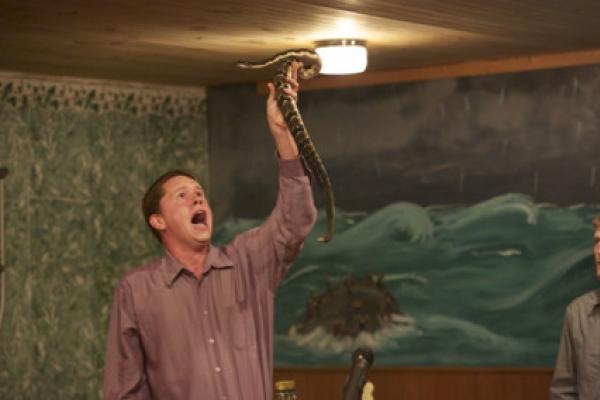If there were such a thing as “spiritual hazard pay” for columnists, I would be filing a claim after watching the first two episodes of the new series “Snake Salvation,” which debuts Tuesday, Sept. 10, on the National Geographic Channel.
God, I hate snakes. I find them utterly repellent; always have. When I was a toddler, my parents had to carry me out of the snake house at the zoo so I would stop screaming as if someone were trying to kill me.
Were it not for professional obligation — you’re welcome, by the way — you would sooner have found me shaving my head with a straight razor than watching a couple of hours of television dedicated to snake handling and its (alleged) spiritual import.
There is a tiny offshoot of the Pentecostal branch of Christianity sometimes referred to as the Holiness Movement that believes God commands the faithful to handle poisonous snakes — rattlers, water moccasins, copperheads — as a part of worship. They believe snake handling is as much a commandment as “Thou shalt not commit adultery,” as one of the show’s preachers, Jamie Coots of the Full Gospel Tabernacle in Jesus Name church in Middlesboro, Ky., says in the premiere episode.
These beliefs are based on a passage from the Gospel of Mark, which says: “And these signs shall follow them that believe; In my name shall they cast out devils; they shall speak with new tongues; They shall take up serpents; and if they drink any deadly thing, it shall not hurt them; they shall lay hands on the sick, and they shall recover.”
In Coots’ church and that of his protege, 22-year-old Andrew Hamblin, pastor of the Tabernacle Church of God in LaFollette, Tenn., worshippers hold venomous serpents above their heads. They also speak in tongues, lay hands on each other as they pray for healing, dance while holding makeshift torches near their faces and occasionally drink poison (such as strychnine) from mason jars.
There are believed to be fewer than 100 of these nondenominational churches, where snake handling is understood to be evidence of (if not a requirement for) salvation. Most are in Appalachia and elsewhere in the rural Southeast.
One of the earliest proponents of snake handling, George Went Hensley, a pastor in Cleveland, Tenn., in the early 1900s, pointed to that passage in Mark 16, as well as a verse in the Gospel of Luke that says, “Behold, I give unto you power to tread on serpents and scorpions, and over all the power of the enemy: and nothing shall by any means hurt you.”
There’s also the story from Acts 28 about the Apostle Paul arriving on the island of Malta and being bitten on the hand by a snake while he was gathering wood to build a fire. The locals expected him to puff up and die from the poisonous bite. Instead, Paul shook the serpent off into the fire and never fell ill.
Such stories, however, would not be understood by the vast majority of Christendom to be the driving force and message of holy writ. For Coots and Hamblin, they are. And however repellent their beliefs and style of worship might be to me, they are treated respectfully in the television series.
Despite its provocative name and exotically creepy subject matter, “Snake Salvation” is not overly sensationalized, perhaps due to its storytelling falling into the hands of the folks at National Geographic. Both men are articulate about their beliefs and the show’s creators let them speak for themselves most of the time.
Neither Coots (who lost the top of a finger from a snakebite a number of years back – his wife keeps the bit that rotted off in a jar so “she’ll always have a part of him with her”) nor Hamblin (who is unemployed, lives on food stamps and has five children with his 21-year-old wife) is depicted as a wild-eyed or illiterate bumpkin.
That my snake-handling brothers and sisters in Christ have fixated on a few obscure passages of Scripture doesn’t bother me nearly as much as those damned snakes.
Even though they take care to keep the children and women away from the snakes during worship services, they’re still waving around 5-foot-long diamondbacks as if they were tambourines.
Watching scenes of the pastors and their faithful companions hunting for snakes — poisonous snakes are pricey and these folks are usually a bit short on cash — I became completely unglued and started shouting at the screen.
DON’T PUT YOUR HAND IN THERE! ARE YOU INSANE?!
WHY?! WHY WOULD YOU PUT YOUR FACE THAT CLOSE TO A DEN OF RATTLERS?!
STOP POKING AT IT! SWEET JESUS, RUN, YOU IDIOTS!
PUT IT IN THE BAG, PUT IT IN THE BAG, PUT IT IN THE BAG!
My son poked his head into the room to see what I was screaming about, but when he saw me filtering the screen through the blanket I’d drawn over my head, he knew.
“Oh,” he said, nonplussed. “Snakes.” He shrugged and walked away.
If your sensibilities aren’t as fragile as mine when it comes to beasts that move on their bellies without legs and whose bite can kill you, then “Snake Salvation” might be right up your alley. For those of you who are curious about “strange” or unusual religious beliefs and practices, the series does a good job of explaining their beliefs and leaving the judgment about theology (and sanity) up to the viewer.
As for me, two episodes were more than enough.
Cathleen Falsani writes for Religion News Service. Via RNS.
Got something to say about what you're reading? We value your feedback!
